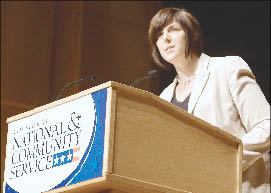 |
|
Goren: Former chief of staff is still acting CEO of CNCS. Photo: Corporation photo by M.T. Harmon |
A new evaluation of the budget process of the Corporation for National and Community Service (CNCS) found outdated policies, a lack of clear lines of command, employees unqualified for the jobs they were assigned and no overall plan for the agency’s computer systems.
Many of the problems cited in the evaluation were identified earlier, in a 2005 management assessment of CNCS by the National Academy of Public Administration, an independent nonprofit organization for public governance. That assessment was requested by Congress after a violation of the Anti-Deficiency Act shut down AmeriCorps programs temporarily because the agency had spent more money than it had been appropriated.
Congress requested the new evaluation last year because of similar overspending. A repeat violation of the deficiency act was staved off only through drastic curtailment of hiring, travel, training and purchasing of needed supplies, according to the evaluation, done by the agency’s Office of Inspector General (OIG).
Despite promises by CNCS Chairman Stephen Goldsmith in 2005 that the recommendations in the earlier assessment would be followed, the latest evaluation found that “the corporation did not take appropriate steps to fix” various problems and they were still “hampering corporation operations” in fiscal 2008.
The findings of the evaluation, which was requested last fall by the House Appropriations subcommittee that oversees CNCS, were clearly the rationale for Rep. David Obey’s decision to trim the proposed CNCS 2010 budget by $90 million, to $1.059 billion. Obey (D-Wis.), chairman of the subcommittee and the full House Appropriations Committee, said in a statement announcing the recommendations that the “subcommittee will consider further expansion of service and volunteer programs once the Corporation for National and Community Service has demonstrated that it has made improvements in its internal operations.”
The money taken out by the House was added back to the bill by the Senate Appropriations Committee, but the appropriations bill still must be passed by the full Senate, then reconciled with the House version.
Ranit Schmelzer, spokewoman for CNCS, did not respond to requests to discuss the new OIG report.
Structural Flaws
Both reports blamed the problems on the corporation’s structure: specifically, a CEO spread too thin, focusing mainly on program operations rather than the overall operation of the agency, without the analytical support needed, because of information technology (IT) shortcomings. They recommended a series of organization changes, including an official who would take over the day-to-day operations and an IT official who would report directly to the CEO.
CNCS has no permanent leadership at its very top. President Barack Obama’s original choice to head the corporation, Nike Vice President Maria Eitel, withdrew before she was nominated formally. Nicola Goren, chief of staff for former CEO David Eisner, has been acting CEO since November. There is also an acting chief financial officer. At the same time, Alan Solomont, the current board chairman, has been nominated to be ambassador to Spain.
Begun under former Inspector General Gerald Walpin, who was fired by Obama in June, the evaluation was sent to Congress by Stuart Axenfeld, assistant inspector general for audit, and includes responses made by the corporation as recently as July 27. But the evaluation, dated Aug. 7, found that the corporation still had not complied with several important budgeting and organizational recommendations that the OIG had made.
For example, the OIG found that the corporation’s budget policy had not been updated since Oct. 1, 2006, despite numerous changes in the corporation structure. Although the corporation’s policy council considered a revision in July, the evaluation found that it had not established any procedure to update the budget policy in the future.
The report also recommended that the corporation develop an “overall Corporation IT strategic plan and review it periodically” with input from the chief of information operation, the corporation management team and program office personnel. The OIG evaluation noted: “The same recommendation was made in October 2005 … but never implemented.”
In its response to the evaluation sent to Congress, the corporation said a new strategic plan should be ready by the end of this calendar year.































